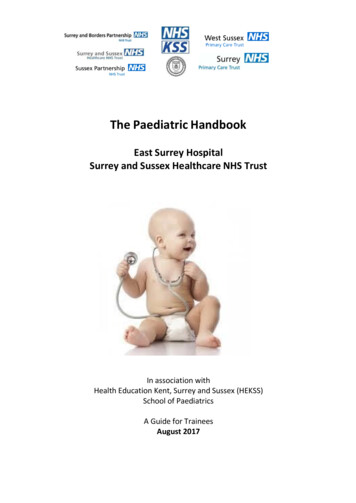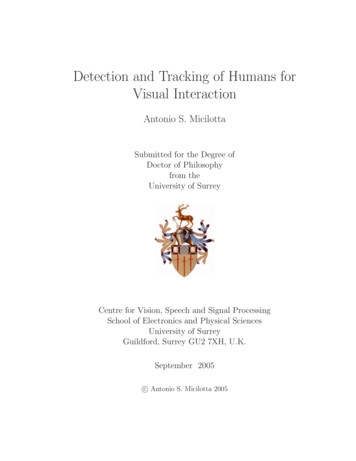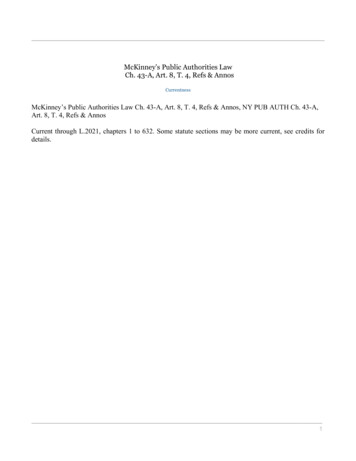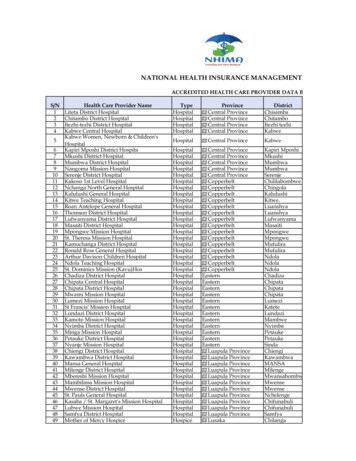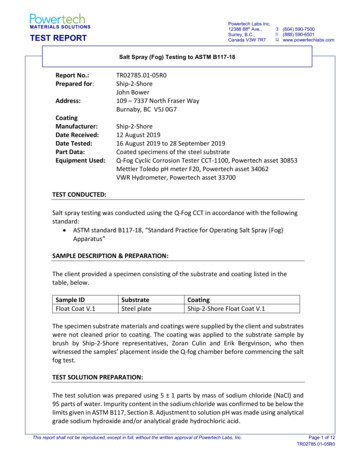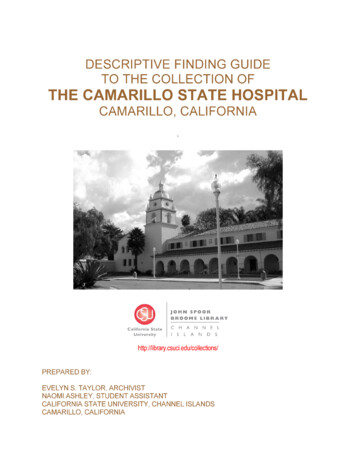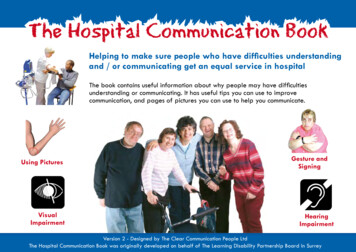
Transcription
The Hospital Communication BookHelping to make sure people who have difficulties understandingand / or communicating get an equal service in hospitalThe book contains useful information about why people may have difficultiesunderstanding or communicating. It has useful tips you can use to improvecommunication, and pages of pictures you can use to help you communicate.Using PicturesVisualImpairmentGesture andSigningHearingImpairmentVersion 2 - Designed by The Clear Communication People LtdThe Hospital Communication Book was originally developed on behalf of The Learning Disability Partnership Board in Surrey
Introduction and ContentsThe first version of The Hospital Communication Book was designed by The Clear Communication People Ltdon behalf of The Learning Disability Partnership Board in Surrey. This is version 2 of the book. We have updatedsome of the wording. We have used more photosymbols, and developed new images to give a more consistent look.This book aims to help hospital staff in 2 ways, and contains 2 sections Section 1 - To give hospital staff basic information about the communication needs people may have Section 2 - To be a practical communication tool people can use to help communicate togetherSection 1 - Information PagesSection 2 - The Picture and Photo Toolkit Page 3 - Communicating with speech Page 9 - Drinks Pages 16, 17, 18 - Procedures Page 4 - Supporting people with visual impairments Page 10 - Food Pages 19 & 20 - Body parts Page 5 - Supporting people with a hearing loss Page 11 - People / alphabet Page 21 - Full Body Page 6 - Using Signing Page 12 - Personal things Page 22 - Nil by Mouth Page 7 - Examples of useful signs Page 13 - Personal care Page 23 - Places Page 8 - Using pictures & photos for communication Page 14 - Symptoms Page 24 - When Do I Go Home ?These pages aim to explain some of the keycommunication issues for people. Also to give youadvice and practical tips on how to communicateclearly with a wide range of people who may havedifficulties communicating. Page 15 - Degree of PainThese are pages of pictures youcan use to offer people choices, explain what is going to happen, and helpthem to communicate to you. Page 8 gives important advice on how to usethe pictures. Not everyone will be able to recognise the meaning of all thepictures. Use them to back up what you are saying.We are keen that you use this book in any way you feel can improve a person’s experience whilst in hospital.You may find it useful to photocopy some of the pages to use seperately. For example the ‘Nil by Mouth’ page can becopied to be displayed above a person’s bed. Most photos used in this book are Photosymbols. Photosymbols is aphoto imagebank you can buy and use. Go to www.photosymbols.com for more information. We have created the linedrawings ourselves. We would like to thank the Bentley Day Service Building Links Group for helping us to develop them.Version 2Originally Developed for the Learning Disability Partnership Board in SurreyGo to www.aboutus.org.uk to find out more about the Surrey Partnership BoardPage 2
Communicating Clearly with SpeechPeople don’t understandall the words we useWe often talk too fastIt takes more time for manypeople to process words they hear.This is true for many people witha learning disability, if English isnot your first language, and alsofor all people when they arefeeling anxious.Use everyday words wherever youcan. Use short simple sentences.Have only one idea in a sentence.You may have a much largervocabulary than the person youare communicating with.Some people with a learning disability may only pick up key words in a sentence.This means they may only take in one, two, or three words of your sentence. For example :Unfortunately due tocomplications it’s notpossible for you togo home yet, wemay know moretomorrowehom wrrotomoIt’s importantto make surethe person hasunderstood themain idea ofyour messageUse very Literal LanguageWhen people are talking to us weunderstand much of their meaningby their tone and body language.Also, we often talk using abstractphrases rather than accuratewords. Look at these phrases.I’ll give you a bell laterThe doctor’s doing her roundsHe can’t see the wood for the treesSome people will be less skilledat interpreting abstract language.They take a more literal meaningfrom words, and can get confused.Using gestures helpsGestures and facialexpressions give visualclues about themeaning of whatyou are saying,as well asslowing down how fast you speak.DON’T SHOUT - IT’S RUDE, AND DOESN’T HELP COMPREHENSION !!!!Version 2Designed by The Clear Communication People LtdGo to www.communicationpeople.co.uk for more information about our workPage 3
Supporting People with Visual Impairments“In the UK 17,000 people with sight problems use a white cane. Another 5000use guide dogs. There are many more who need help with their everyday living”.Be aware how you explain things.We often talk in a very visual way.For example when asked where thetoilet is “the green door on the right”is not a helpful answer! If you arephysically shown you can work theroute out for yourself.There are around 23,000people in the UK whohave a severe loss of bothsight and hearing.About 200,000 haveless serious dualsensory loss.To make hand writing more legible,choose a dark felt tip pen and writeneatly using thicker strokes. Be awarethat some people have good visionin a limited area so would be ok withsmaller print.Avoid clutter! Try to minimise the riskof someone tripping over thingsIt’s important to take the time to tell people where theimportant things are like toilets, call buttons, and drinks.People may need a bit of time before they are confident. Itcan help people to have a bed near a landmark in the room,say a bed at the end rather than in the middle.Good lighting is important. A clip on readinglamp may be useful for a person to have.A magnifying glass may be useful to have around theward for people who have a visualimpairment to use to read.Be aware that people have a varietyof sight difficulties and a magnifiermay not meet their needs.Encourage people to bring in their own magnifier.Menus and food are a very common difficulty for people with sight problems in hospitalPeople will often have difficulty reading and ticking the menus as they are usually printed in very smallwriting. Read the menu out for someone or enlarge it on the photocopier if someone reads large print.Meals may be left on a tray, on a table, which is out of reach near the end of the bed. Someone whohas a visual impairment may not see the meal and miss their food. It’s important that staff take the timeto describe to the person what is happening & where things are.Version 2Designed by The Clear Communication People LtdGo to www.communicationpeople.co.uk for more information about our workPage 4
Supporting People with a Hearing LossFirstly, establish how the deaf person communicates.If they are asking you a question using their voice, it is safeto assume that they will be expecting to lip-read your reply. Face the person directly, if you look awaythe deaf person cannot see your lips. Speak clearly at a normal pace. Do not shoutMime driving a car to ask if you can give them a lift. Pointto objects to give clues, or point to give directions. Showsize and shape with your hands Use facial expressions to help convey meaning. Fingerspelling - Deaf people usually fingerspell names,places, and unusual words. Make sure you have good light on your face so theperson can see your features and read your lips easily. Use whole sentences rather than one word replies lip-reading is 70% guess work and many wordslook the same. Using sentences gives contextual clues. Be patient, if you are asked to repeat something trychanging the sentence slightly, it may make it easierto understand.If the person has a learningdisability and a hearing loss thenplease note this general advice abouthearing loss, but also allow for theperson’s learning disabilitysee advice on page 3. Do not give up, if you cannot make yourselfunderstood then try writing it down or drawingwhat you mean. If the person is a sign language user, they willprobably still expect to have to try to lip-read yourreply. Very few hearing people sign, and deaf peopleare used to trying to communicate with hearing people. Use gestures to help explain what you are saying.Use gestures, point, mime to help explain what you aresaying. E.g. Show a cup and ask what they want to drink.Version 2Designed by The Clear Communication People LtdGo to www.communicationpeople.co.uk for more information about our workPage 5
Using Signing To Support SpeechThe main benefit of using signingwith speech is that it makescommunication visual.People can see what you aresaying as well as hearing it.British Sign Language (BSL)BritishSignLanguagePeople then have more ways ofunderstanding the message.Some people use signs to supportthe words they are speaking. Manypeople who aquired a hearing losslater in life use signing in this way.On the following page we have included diagrams of a few signs you may finduseful on a hospital ward. These are signs for things not easily representedby a picture. It’s good to use the pictures where you canSome signs have anarrow which shows youthe direction to moveyour hand. The doubleheaded arrows heremean up and down.dinnerA morespecificaction isexplainedin writing.A deaf person may need thesupport of an interpretor. Contactyour local Deaf Services Team.Makaton SigningmotherTo explain that you are going for a drive you might say‘we are going in the car’ as it keeps the language simple.The limitation of signing is that, as with speech, when you stopsigning the message is gone and relies on the person’s memory.Version 2Is a full visual language usedby many deaf people tocommunicate. Not everyonewho signs uses the full BSL.Designed by The Clear Communication People LtdGo to www.communicationpeople.co.uk for more information about our workMakaton is a language programmeintegrating speech, manual signs, andgraphic symbols. Many people with alearning disability use Makaton.Key words are signed.We are going to theshop in the car.You only sign the bold words.Contact Makaton for advice on training.Their website is www.makaton.orgPage 6
Useful Makaton SignsEatDrinkYesNo(oftenused as‘home’)ToiletHousePleaseThank YouSleepPainGoodBadPlease Note : These signs are from the Makaton Vocabulary Development Project. They are used here for illustration.People learn Makaton signing in groups supported by Makaton representatives. Please go to www.makaton.org for more informationVersion 2Designed by The Clear Communication People LtdGo to www.communicationpeople.co.uk for more information about our workPage 7
Using Photos, Pictures and SymbolsPhotos, Pictures and symbolscan help people to:Understand InformationMany people with a learning disability donot read, and some people find it hard tounderstand when you explain things.Pictures can help get your message across.Tell you what they needSome people with a learning disabilitydo not communicate verbally. Somepeople‘s speech can be hard tounderstand. Pictures can help themget their message acrossMake choicesMany people find it hard to makechoices in their head. Havingpictures to look at helps.One benefit of using pictures is that they arepermanent. Once you stop speaking or signing yourely on the person’s memory.The pictures we have included on the next few pages may help youto communicate more clearly with a wide range of people.Version 2Many people with a learning disability will be familiarwith some pictures and symbols. They will use them day today to communicate. It is good if they bring their owncommunication tool into hospital with themNote of CautionA picture, photo, or symbol is only a 2 dimensionalrepresentation of an object or idea. Not all peoplewith a learning disability will take a meaning froma picture, photo, or symbol.Some people have a very profound disability anddo not use pictures and symbols at all. Using anobject, like a cup or a gown, can help to explainwhat you’re saying.Many pictures and symbols look like what they represent - others aremore abstract. If you can’t easily tell what a picture represents otherpeople will struggle too, and will need help. Remember that manypeople won’t be able to read the word underneath.Total CommunicationTotal Communication is about not relying on just one methodof communication. A person may use a mixture of speech,gesture and pictures to get their message across.We need to be able to adapt how we communicate for eachperson we meet.Designed by The Clear Communication People LtdGo to www.communicationpeople.co.uk for more information about our workPage 8
Pictures of DrinksTeaCoffeeMilkSugarLemonOrangeHot ChocolateFizzy DrinkSquashBlackcurrantRed FruitsMilkshakeVersion 2WaterJuiceDesigned by The Clear Communication People LtdGo to www.communicationpeople.co.uk for more information about our workLimePage 9
Pictures of CakeCerealToastBiscuitsChocolateVersion 2Designed by The Clear Communication People LtdGo to www.communicationpeople.co.uk for more information about our workPage 10
Pictures of People / AlphabetFemale DoctorPartnerMale DoctorPartner Female NurseMale ndA B C D E F G H I J K L M NO P Q R S T U V W X Y ZVersion 21 2 3 4 5 6 7 8 9 10Designed by The Clear Communication People LtdGo to www.communicationpeople.co.uk for more information about our workPage 11
Pictures of Personal ThingsnightGlassesHearing rWalking FrameWalking StickShoes & SlippersVersion 2Designed by The Clear Communication People LtdGo to www.communicationpeople.co.uk for more information about our workPage 12
Personal Care ush teethBrush hairSanitary wearDressing GownToiletriesMake upVersion 2Designed by The Clear Communication People LtdGo to www.communicationpeople.co.uk for more information about our workPage 13
Pictures of SymptomsHotColdHeadacheDizzyBackacheStomach AcheSore ThroatChest PainConstipationDiarrhoeaTiredSickVersion 2Designed by The Clear Communication People LtdGo to www.communicationpeople.co.uk for more information about our workPage 14
Degree of painHappyVersion 2OKIn PainDesigned by The Clear Communication People LtdGo to www.communicationpeople.co.uk for more information about our workBad PainPage 15
Pictures of tureTabletsMedicineSling75Mouth careVersion 2Nail carePulseDesigned by The Clear Communication People LtdGo to www.communicationpeople.co.uk for more information about our workBlood PressurePage 16
Pictures of EGEndoscopySigmoidoscopyEEGHeart Monitor/ECGNaso-gastric tubeUrine TestOperationVersion 2Designed by The Clear Communication People LtdGo to www.communicationpeople.co.uk for more information about our workPage 17
Pictures of ProceduresBlood TestBlood TestSuppositoryEnemaPicturesfor movingStitchesX RaySit in chairStay inbedDon’t walkInjectionVersion 2InjectionDesigned by The Clear Communication People LtdGo to www.communicationpeople.co.uk for more information about our workPage 18
Body hestBreastsVersion 2Designed by The Clear Communication People LtdGo to www.communicationpeople.co.uk for more information about our workPage 19
Body ToeFingerVersion 2Designed by The Clear Communication People LtdGo to www.communicationpeople.co.uk for more information about our workPage 20
Full BodiesVersion 2Designed by The Clear Communication People LtdGo to www.communicationpeople.co.uk for more information about our workPage 21
Nil By MouthNo FoodVersion 2No DrinkDesigned by The Clear Communication People LtdGo to www.communicationpeople.co.uk for more information about our workPage 22
Pictures of PlacesCHWardHomeTransportchapelcafeday centreTV RoomdayGardenshopNewspaperVersion 2MagazineFlowersDesigned by The Clear Communication People LtdGo to www.communicationpeople.co.uk for more information about our workSnacksDrinkPage 23
When do I go home ?MonTuesMondayTuesdaynightnight7 nightsVersion 26 nightsWedThursWednesdayThursdaynight5 nightsnight4 nightsFriFridaynight3 nightsDesigned by The Clear Communication People LtdGo to www.communicationpeople.co.uk for more information about our workSatSaturdaynight2 nightsSunSundaynightHome1 nightPage 24
British Sign Language (BSL) Is a full visual language used by many deaf people to communicate. Not everyone who signs uses the full BSL. Some people use signs to support the words they are speaking. Many people who aquired a hearing loss later in life use signing in this way. A de


